Research on the Variable-Temperature Cracking Mechanism of CRTS I Type Double-Block Ballastless Track on a Bridge
Abstract
:1. Introduction
2. The Establishment of a Finite Element Model
2.1. Basic Dimensions and Parameter Settings of the Model
2.2. Material Parameters and Working Boundary Conditions
2.3. Simulation Method of the Temperature Field Load
2.4. Model Reliability Verification
3. Analysis of Results of the Pure Thermal Model of the CRTS I TDBBT on the Bridge
3.1. Selection of Temperature Load Parameters and Optimization Scheme
3.2. Analysis of the Vertical Temperature Gradient Distribution
3.3. Analysis of the Time-Dependent Deformation of the Vertical Temperature Gradient of the Track Slab
4. Analysis of Results of the Sequential Thermal Stress Coupled Model of the CRTS I TDBBT on the Bridge
4.1. Analysis of the Issues of the Track Slab with Normal Reinforcement under a Temperature Load
4.2. Longitudinal Temperature Load Distribution on the Surface of the Track Slab under Normal Reinforcement
4.3. Longitudinal Temperature Load Distribution between Layers of the Track Slab under Normal Reinforcement
4.4. Analysis of Temperature Stress Change after Adding Anti-Cracking Reinforcement
4.5. Analysis of Temperature Stress Change after Adding Expansion Joints
4.6. Comparison of Maximum Temperature Stress and Temperature Gradient
5. Conclusions
- (1)
- The temperature gradient in the middle of the track slab is the largest; the maximum positive and negative temperature gradients are +62.32 and −31.02 °C, respectively.
- (2)
- The middle of the surface of the track slab is prone to more cracks as longitudinal temperature stress is slightly larger than lateral temperature stress. At the edges of the sleeper, a 45° diagonal crack is likely to develop and propagate laterally. Deep cracks occur at the edge of the track slab as longitudinal temperature stress is much larger than lateral temperature stress.
- (3)
- The longitudinal temperature stress of each measuring point along the track slab gradually increases, and the longitudinal temperature stress reaches the maximum at the mid-span of the track slab, where the increscent multiple can be up to 5.5 times.
- (4)
- From the surface of the track slab to the bottom of the track slab, the lateral and longitudinal temperature stresses gradually reduce. The lateral and longitudinal stresses reduce by up to 4 times and 4.6 times, respectively.
- (5)
- On increasing the anti-cracking reinforcement, the longitudinal stress of the track slab is reduced by at most 5.27%. Therefore, an increase in anti-cracking reinforcement helps to prevent cracking of the track slab due to a temperature load, but the effect is not significant.
- (6)
- The third-order and second-order origin moment standard values of the temperature stress of the track on the traditional bridge are −3.104 and 2.814 MPa, respectively. After increasing the expansion joint, the origin moments reduce to −2.662 and 2.496 MPa, respectively, which leads to a decrease in the degree of temperature stress deviation and dispersion of the track, which enhances the resistance as compared to the traditional structure.
Author Contributions
Funding
Institutional Review Board Statement
Informed Consent Statement
Data Availability Statement
Conflicts of Interest
References
- Wang, P.; Gao, L.; Hou, B.W. Influence of rail cant on wheel-rail contact relationship and dynamic performance in curves for heavy haul railway. Appl. Mech. Mater. 2013, 2555, 381–387. [Google Scholar] [CrossRef]
- Yu, Z.W.; Shan, Z.; Yuan, J.; Li, X. Performance deterioration of heavy-haul railway bridges under fatigue loading monitored by a multisensor system. J. Sens. 2018, 2018, 5465391. [Google Scholar] [CrossRef] [Green Version]
- GonçalvesPereira, M.; Fernandes, L.; Leuschner, A.; Barreto, J.; Falcão, D.; Firmino, H.; Mateos, R.; Orrell, M. Development of a machine vision system for the inspection of heavy-haul railway turnout and track components. Transp. Res. Rec. J. Transp. Res. Board 2013, 2376, 71–80. [Google Scholar]
- Zhang, D.W.; Zhai, W.; Wang, K. Dynamic interaction between heavy-haul train and track structure due to increasing axle load. J. Struct. Eng. 2017, 8, 190–203. [Google Scholar] [CrossRef]
- Kaewunruen, S.; Remennikov, A.M. Influence of Ballast Conditions on Flexural Responses of Railway Concrete Sleepers. J. Concr. Int. Aust. 2009, 35, 57–62. [Google Scholar]
- Giannakos, K. Deflection of a railway reinforced concrete slab track: Comparing the theoretical results with experimental measurements. Eng. Struct. 2016, 122, 296–309. [Google Scholar] [CrossRef]
- Han, Y. Cause and Prevention Measures of Ballast Bed Slab Cracks of CRTS I Double-block Ballastless Track in Arid Area. Railw. Constr. 2018, 58, 112–115. (In Chinese) [Google Scholar]
- Öberg, J.O.H.A.N.; Andersson, E. Determining the deterioration cost for railway tracks. Proc. Inst. Mech. Eng. Part F J. Rail Rapid Transit 2009, 223, 121–129. [Google Scholar] [CrossRef]
- Luo, J.; Zhu, S.; Zhai, W. An advanced train-slab track spatially coupled dynamics model: Theoretical methodologies and numerical applications. J. Sound Vib. 2021, 501, 116059. [Google Scholar] [CrossRef]
- Magel, E.E.; Kalousek, J. The application of contact mechanics to rail profile design and rail grinding. Wear 2002, 253, 308–316. [Google Scholar] [CrossRef]
- Luo, J.; Zhu, S.; Zhai, W. Development of a track dynamics model using Mindlin slab theory and its application to coupled vehicle-floating slab track systems. Mech. Syst. Signal Process. 2020, 140, 106641. [Google Scholar] [CrossRef]
- Zhu, S.Y.; Cai, C.B. Interface damage and its effect on vibrations of slab track under temperature and vehicle dynamic loads. Int. J. Non-Linear Mech. 2014, 58, 222–232. [Google Scholar] [CrossRef]
- Zhu, S.Y.; Luo, J.; Zhai, W.; Cai, C.B. Mechanical characteristic variation of ballastless track in highspeed railway: Effect of vehicle-track interaction and environment loads. Railw. Eng. Sci. 2020, 28, 408–423. [Google Scholar] [CrossRef]
- Wu, B.; Zhang, Y.; Zeng, Z.P.; XU, Q.Y.; Li, P. Study on mechanics and crack behavior of twin-block ballastless track on subgrade under the temperature and shinkage load. J. Railw. Sci. Eng. 2011, 1, 19–23. (In Chinese) [Google Scholar]
- Gao, Z.Z. Research on Optimized Design of CRTS I Double-block Ballastless Track. Railw. Stand. Des. 2017, 61, 13–18. (In Chinese) [Google Scholar]
- Wang, S.; Yang, R.; Liu, X.; Wang, P.; Qian, Z. Causes of cracks in ballastless track and remedial measures. Railw. Constr. 2007, 9, 76–79. (In Chinese) [Google Scholar]
- Liu, F.; Zeng, Z.; Wu, B.; Zhang, Z.C. Study on Temperature Field of Continuous Ballastless Track for High-speed Railway. J. China Rail Soc. 2016, 38, 86–93. (In Chinese) [Google Scholar]
- Liu, X.; Li, J.; Kang, W.; Liu, X.K.; Yang, R.S. Simplified Calculation of Temperature in Concrete Slabs of Ballastless Track and Influence of Extreme Weather. J. Southwest Jiaotong Univ. 2017, 52, 10. (In Chinese) [Google Scholar]
- Moreira, D.C.; Nunes, L.C.S.; Sphaier, L.A. Infrared thermography for estimating the thermal conductivity augmentation of polymeric nanocomposites. High Temp. High Press. 2015, 44, 3–23. [Google Scholar]
- Jiang, J.H.; Yuan, Y.S. Action Spectrum of Temperature in Natural Climate Environment and Prediction of Temperature Response in Concrete. Proc. Earth Planet. Sci. 2009, 1, 444–450. [Google Scholar]
- Palanisamy, K.; Nithyanandam, T. Experimental Investigation on Convective Heat Transfer And Pressure Drop In VertIcal And lateral Helically Coiled Tube Heaf Exchanger Using Mwcnt/water Nanofluid. J. Mech. Prod. Eng. 2018, 8, 41–49. [Google Scholar]
- Cai, S.; Wang, Z.; Wang, S.; Perdikaris, P.; Karniadakis, G.E. Physics-Informed Neural Networks (PINNs) for Heat Transfer Problems. J. Heat Trans. 2021, 143, 060801. [Google Scholar] [CrossRef]
- Taler, D.; Dzierwa, P.M.; Trojan. Numerical Modeling of Transient Heat Transfer in Heat Storage element with Channel Structure. Appl. Therm. Eng. 2019, 149, 841–853. [Google Scholar] [CrossRef]
- Lou, P.; Zhu, J.P.; Dai, G.L.; Yan, B. Experimental Study on Bridge–track System Temperature Actions for Chinese High-speed Railway. Arch. Civ. Mech. Eng. 2018, 18, 451–464. [Google Scholar] [CrossRef]
- Cho, B.; Park, D.; Kim, J.; Hamasaki, H. Study on the Heat-moisture Transfer in Concrete under Real Environment. Constr. Build. Mater. 2017, 132, 124–129. [Google Scholar] [CrossRef]
- Elghazaly, A.S.; El-Konsol, S.; Sabbah, A.S.; Hosni, H. Anisotropic radiation transfer in a two-layer inhomogeneous slab with reflecting boundaries. Int. J. Therm. Sci. 2017, 120, 148–161. [Google Scholar] [CrossRef]
- Xu, Y.; Xu, Q.; Chen, S.; Li, X. Self-restraint thermal stress in early-age concrete samples and its evaluation. Constr. Build. Mater. 2017, 134, 104–115. [Google Scholar] [CrossRef]
- Zenkour, A.M.; Abbas, I.A. Nonlinear Transient Thermal Stress Analysis of Temperature-dependent Hollow Cylinders Using a Finite Element Model. Int. J. Struct. Stab. Dyn. 2014, 14, 1450025. [Google Scholar] [CrossRef]
- Hui, K.; Chen, W.; Li, S.; Zhao, Q.; Yan, J. Experimental study on transient thermal–hydraulic characteristics of an open natural circulation for the passive containment cooling system. Int. J. Heat Mass Trans. 2021, 179, 121680. [Google Scholar] [CrossRef]
- Jin, L.; Zhang, R.; Du, X. Computational homogenization for thermal conduction in heterogeneous concrete after mechanical stress. Constr. Build. Mater. 2017, 141, 222–234. [Google Scholar] [CrossRef]
- GB 50010-2010, Code for Design of Concrete Structures. China Building Industry Press: Beijing, China, 2010. (In Chinese)
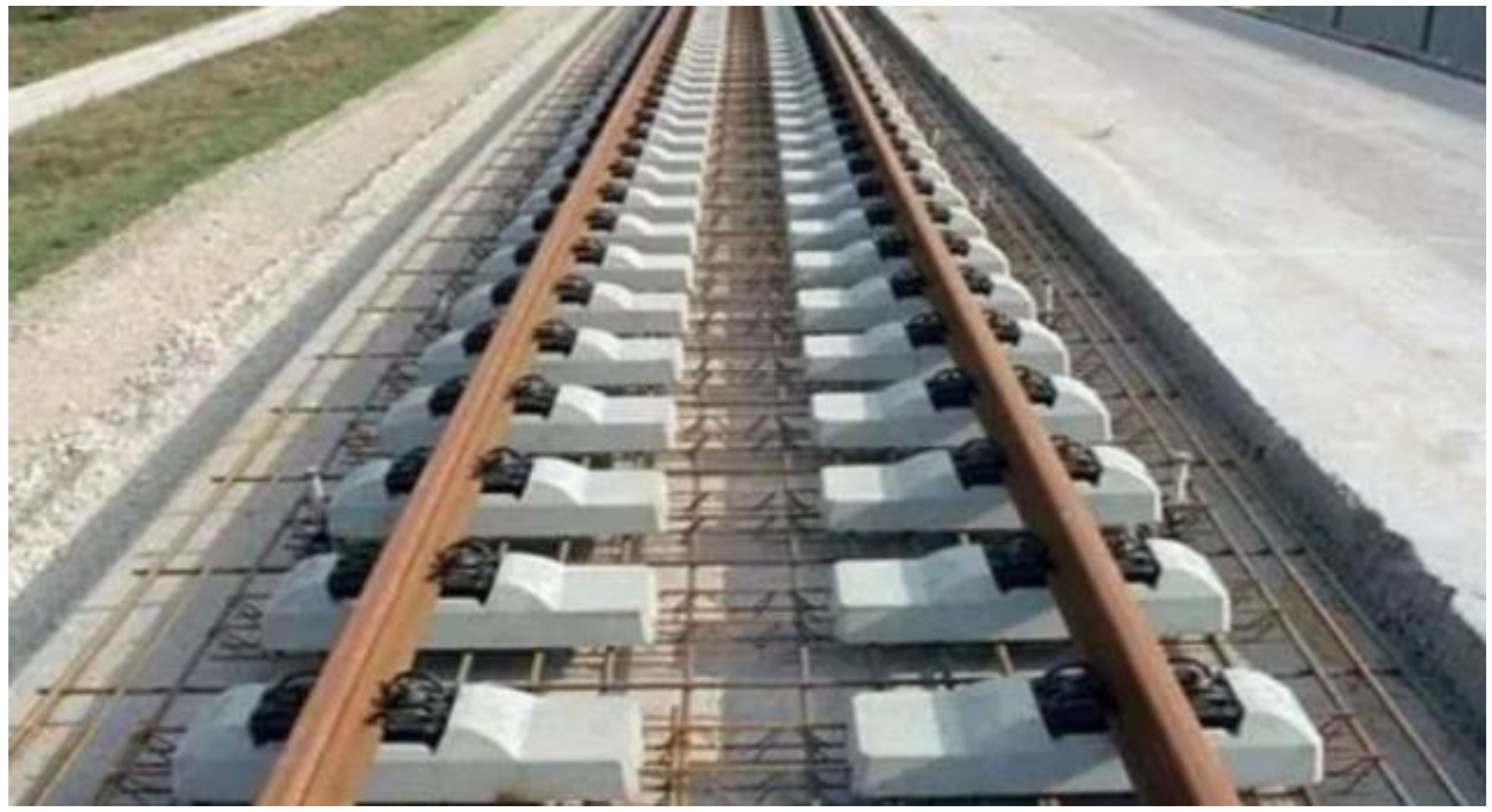
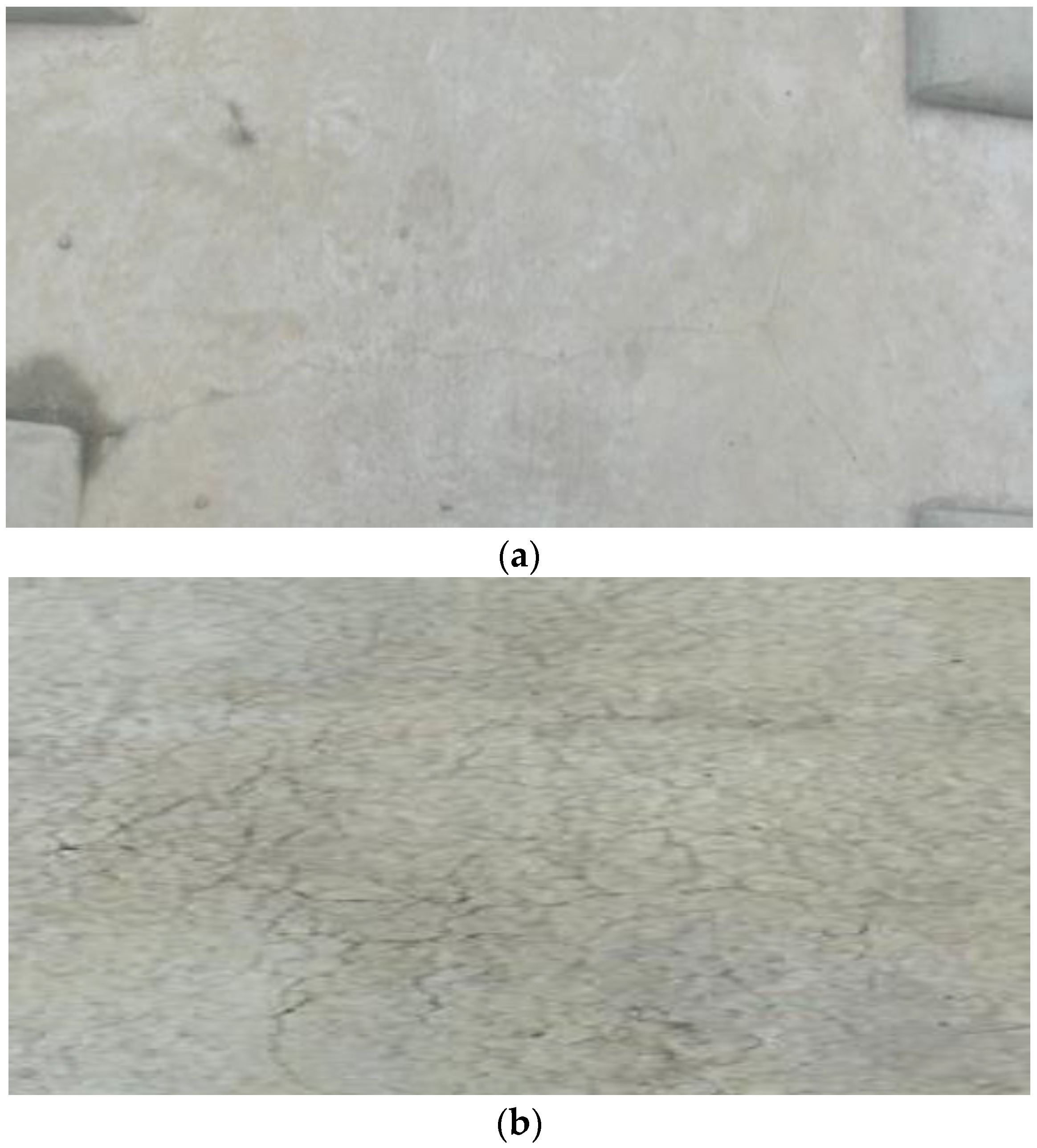


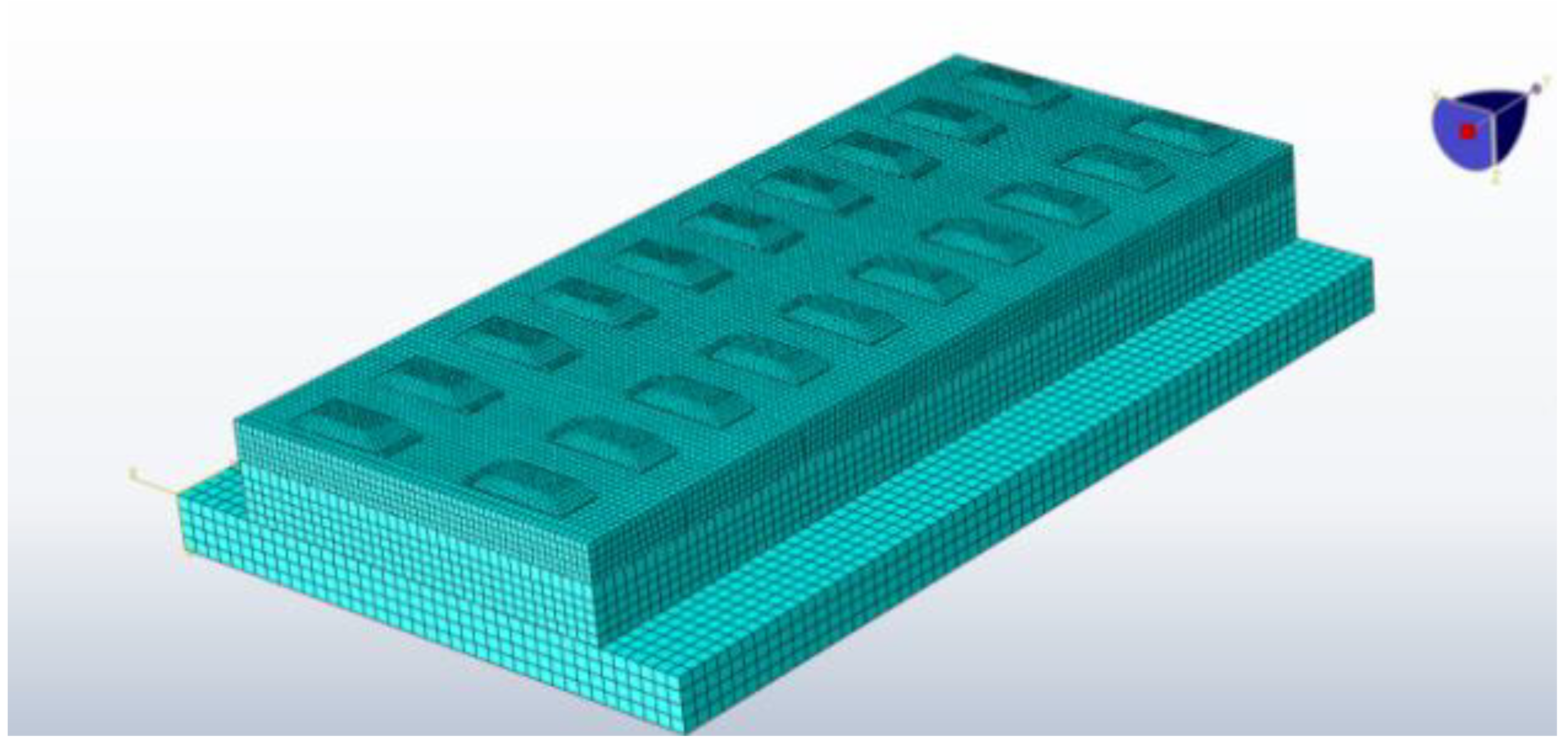



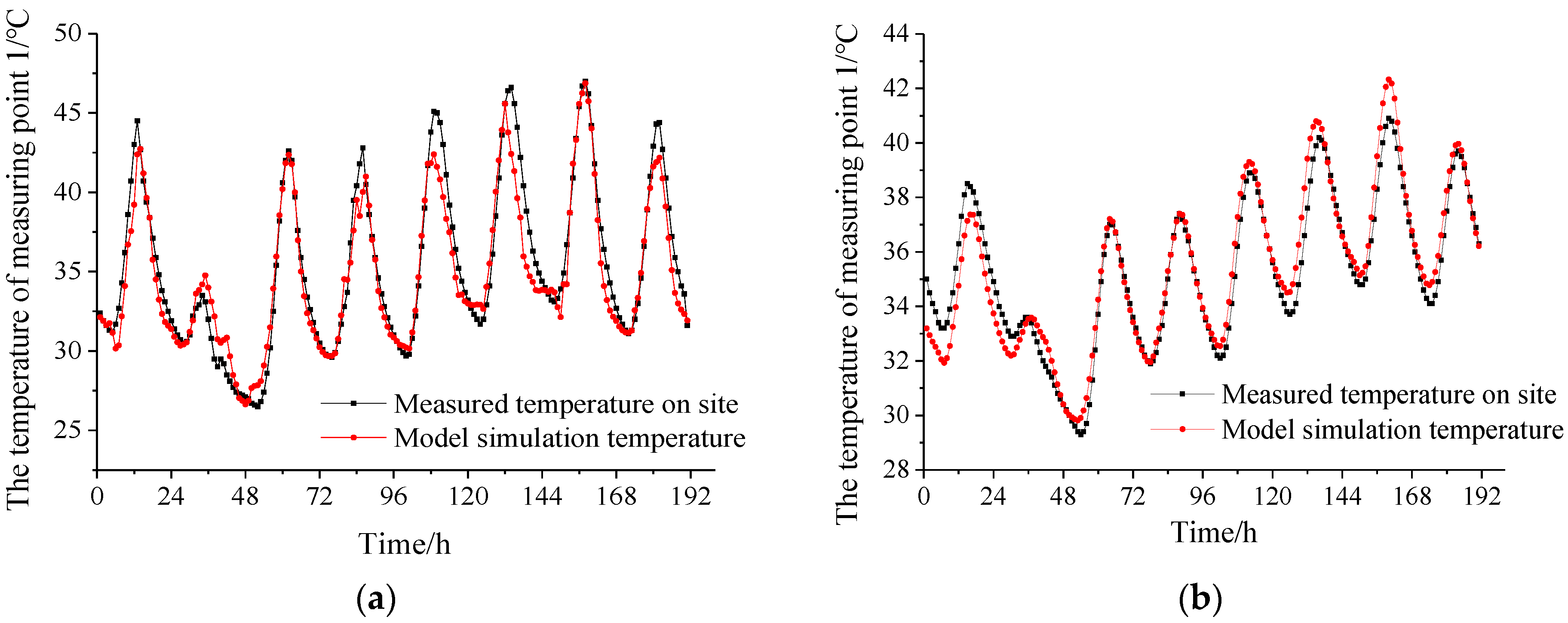
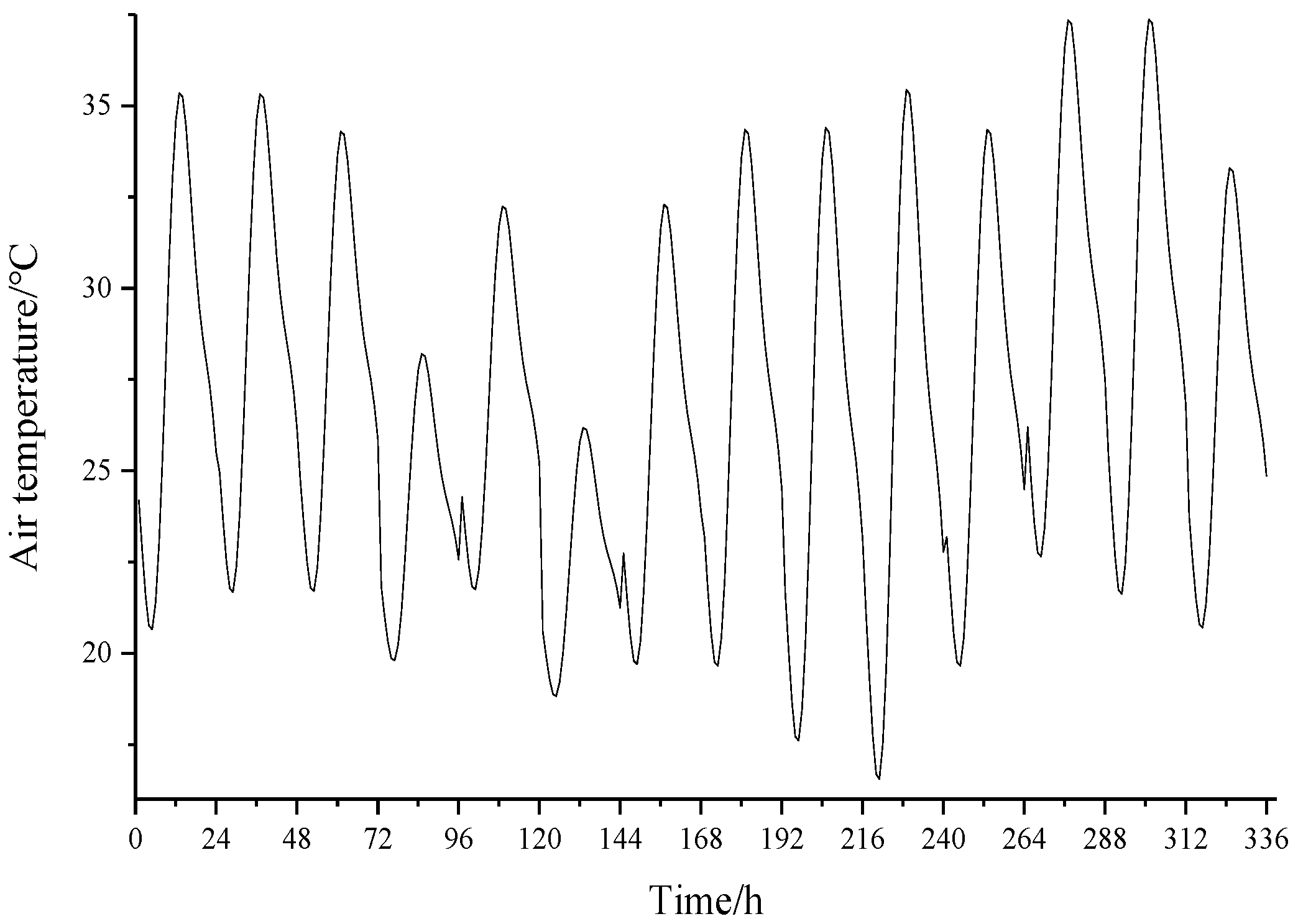
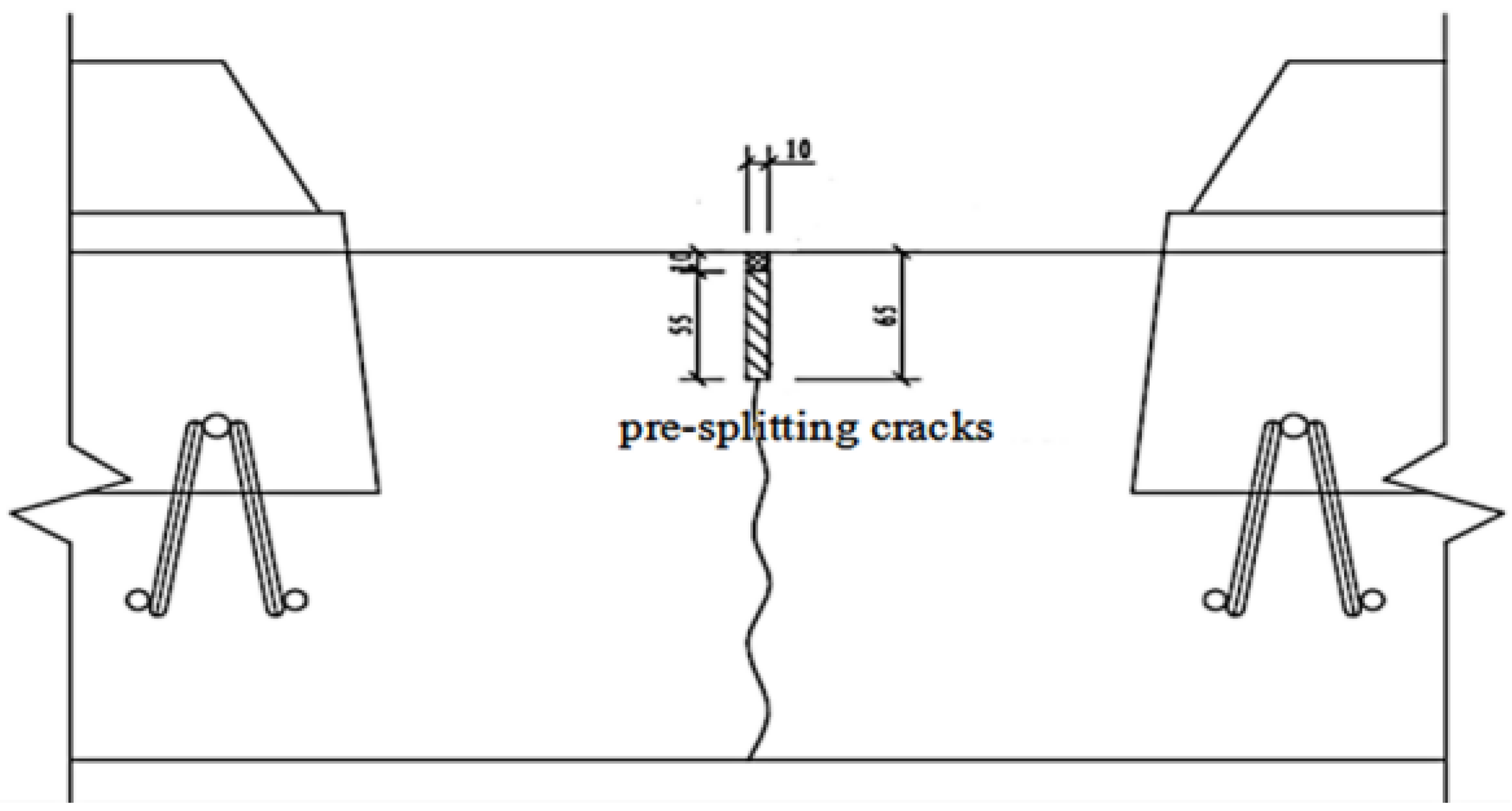
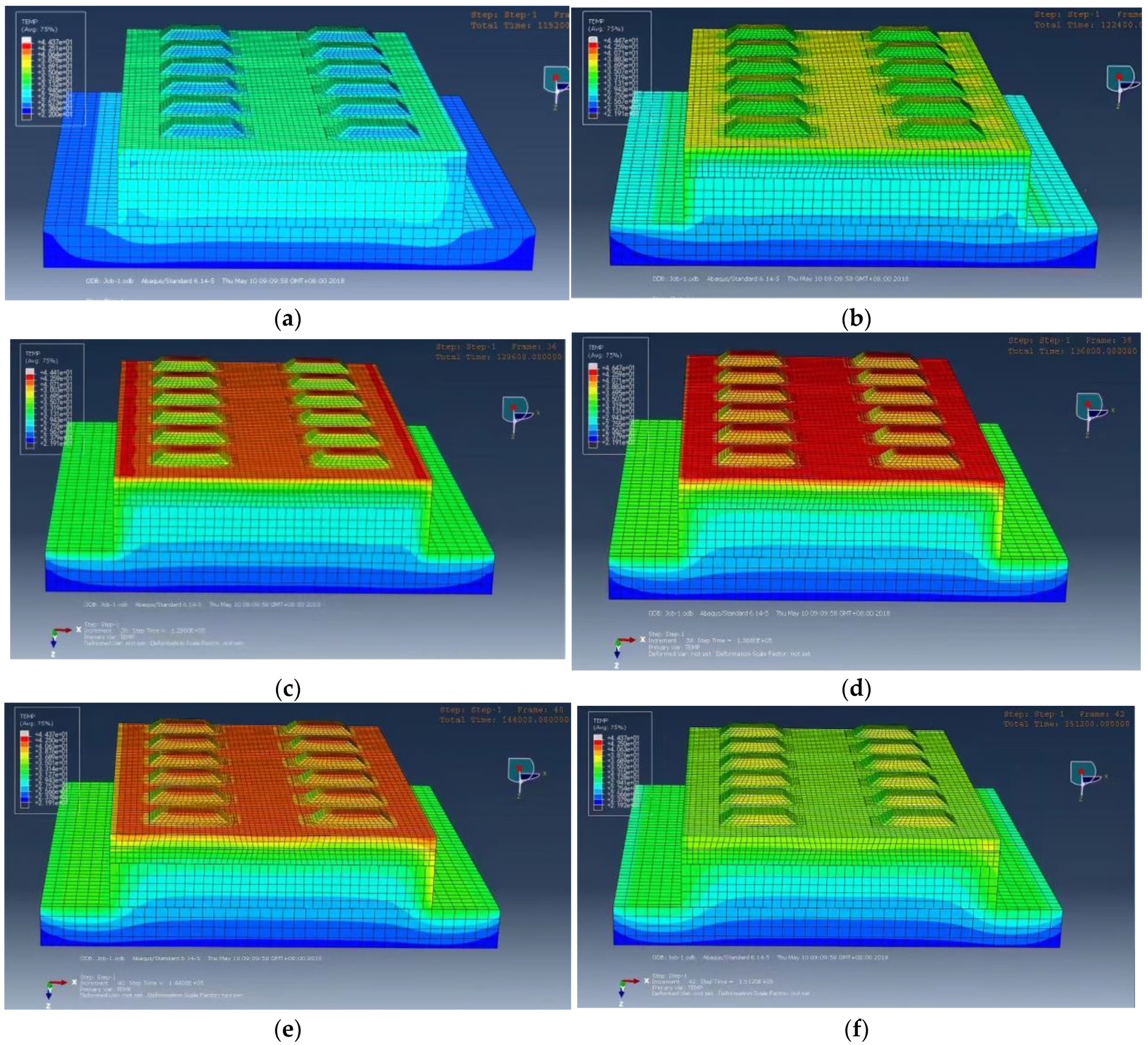

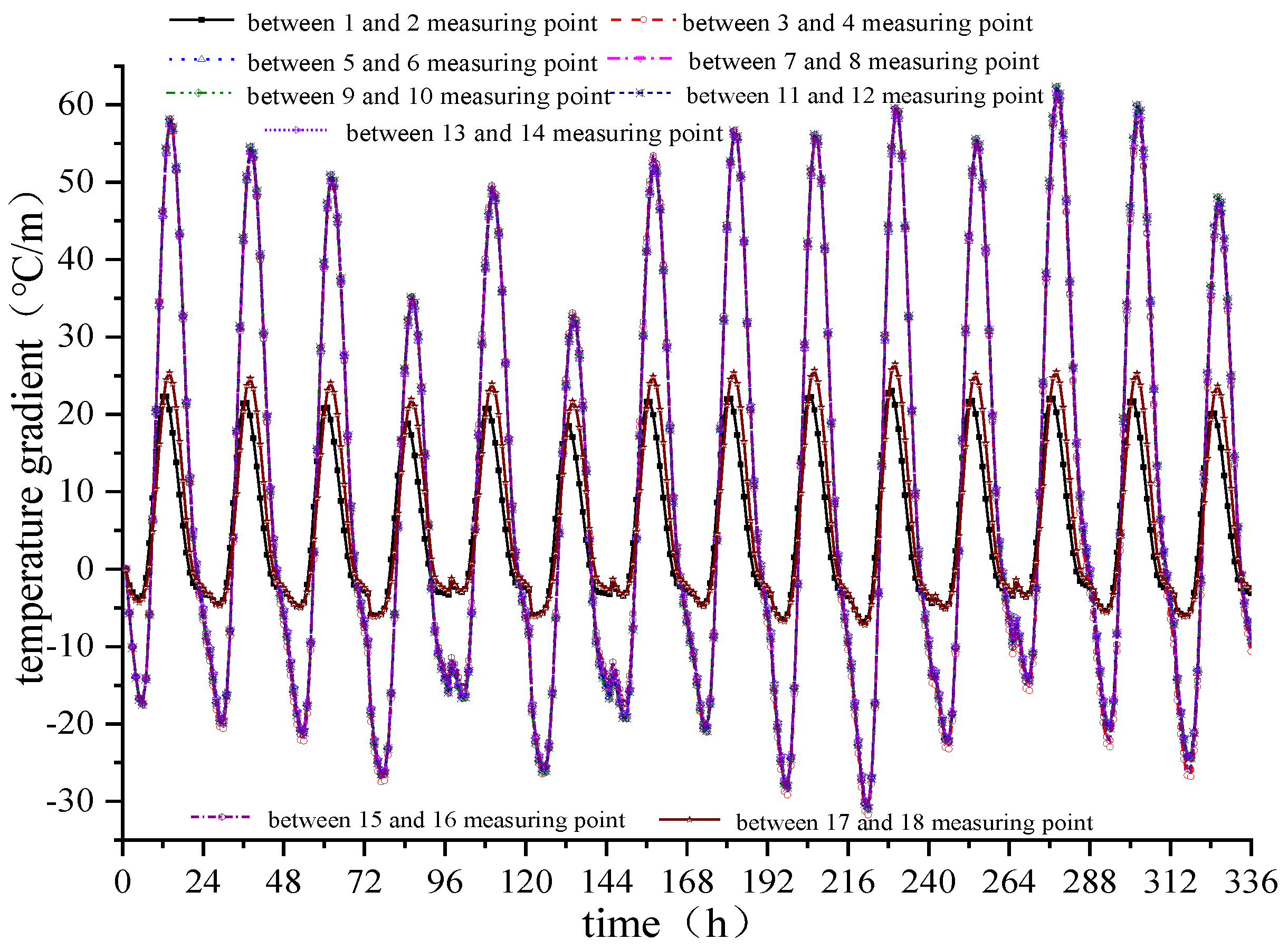

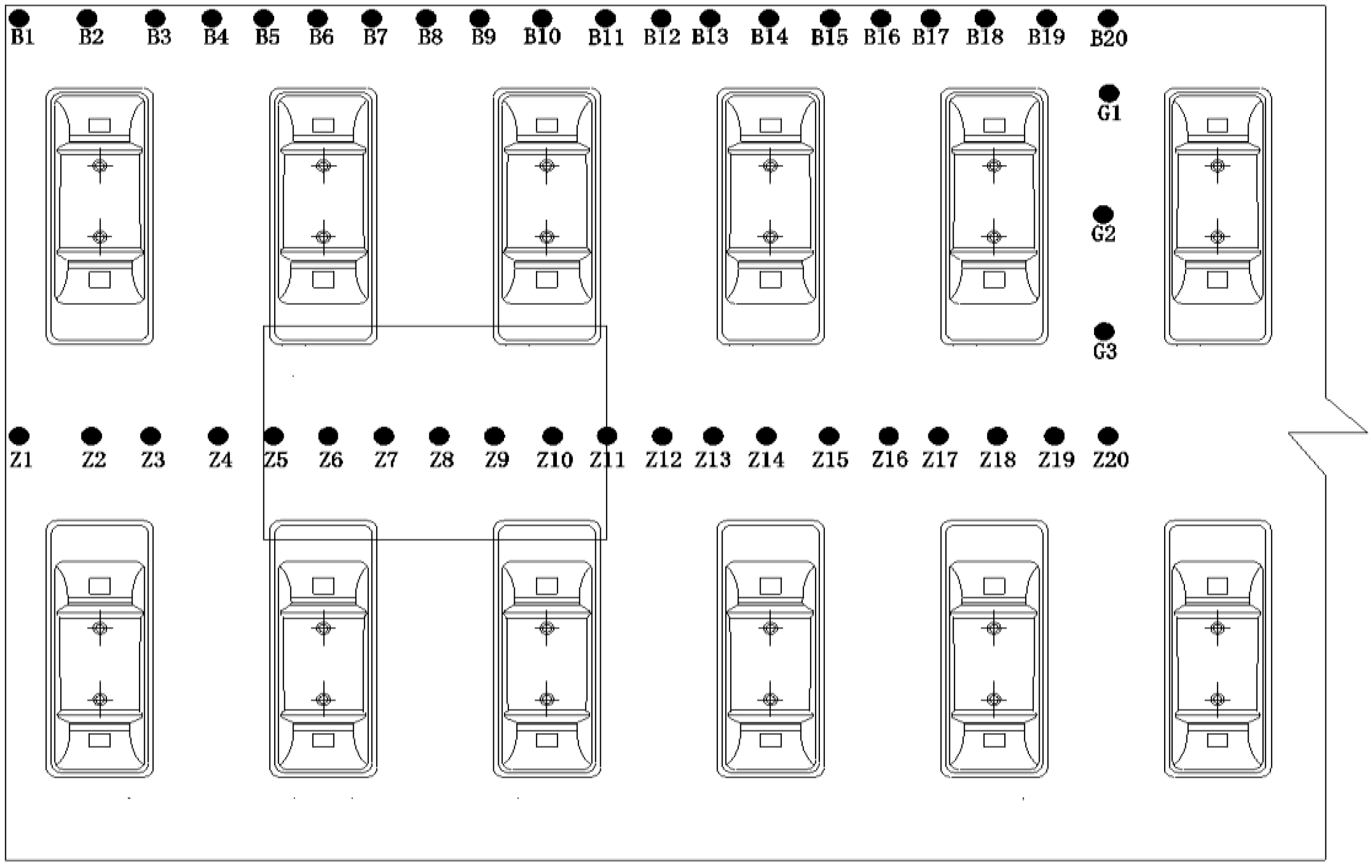
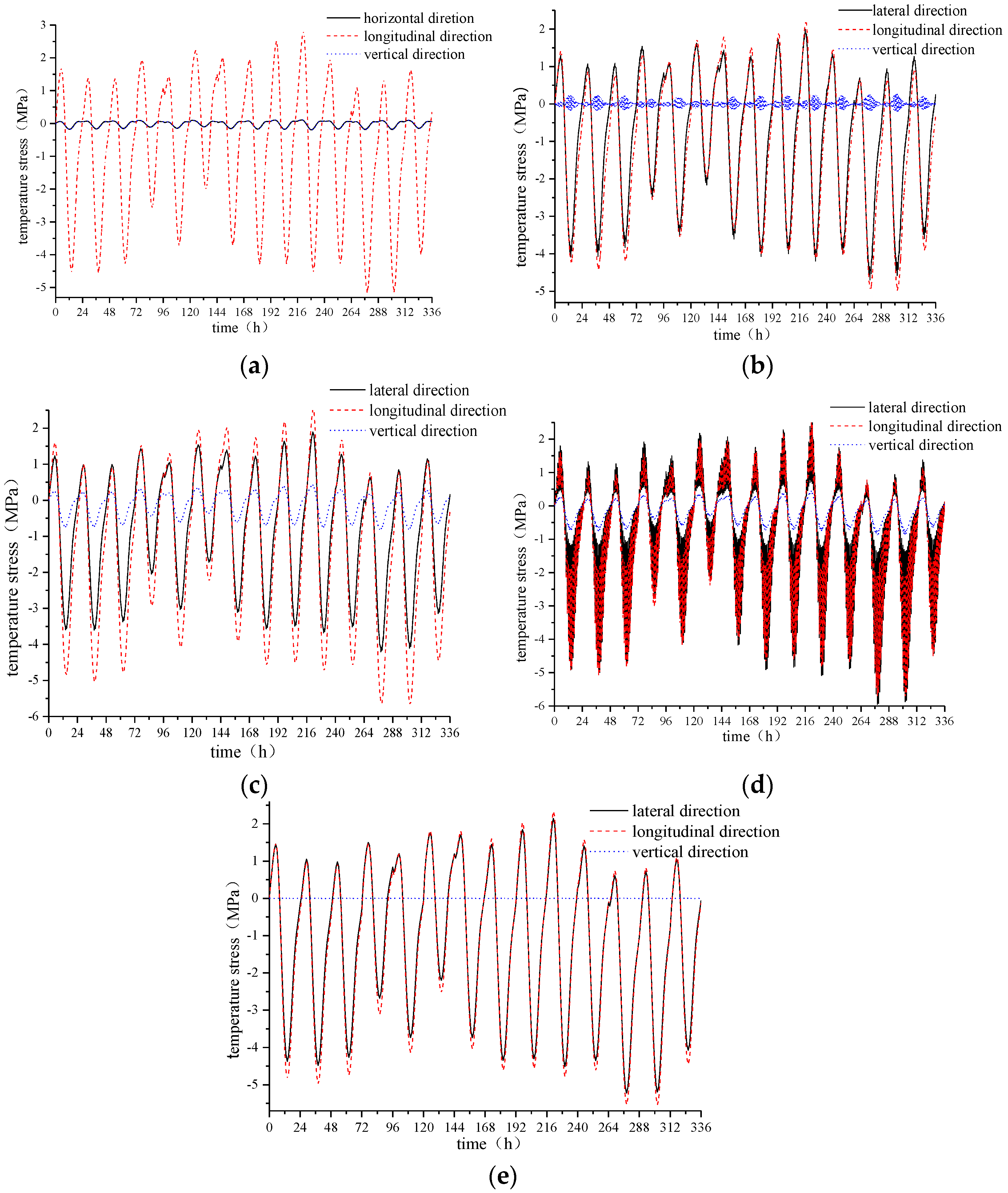
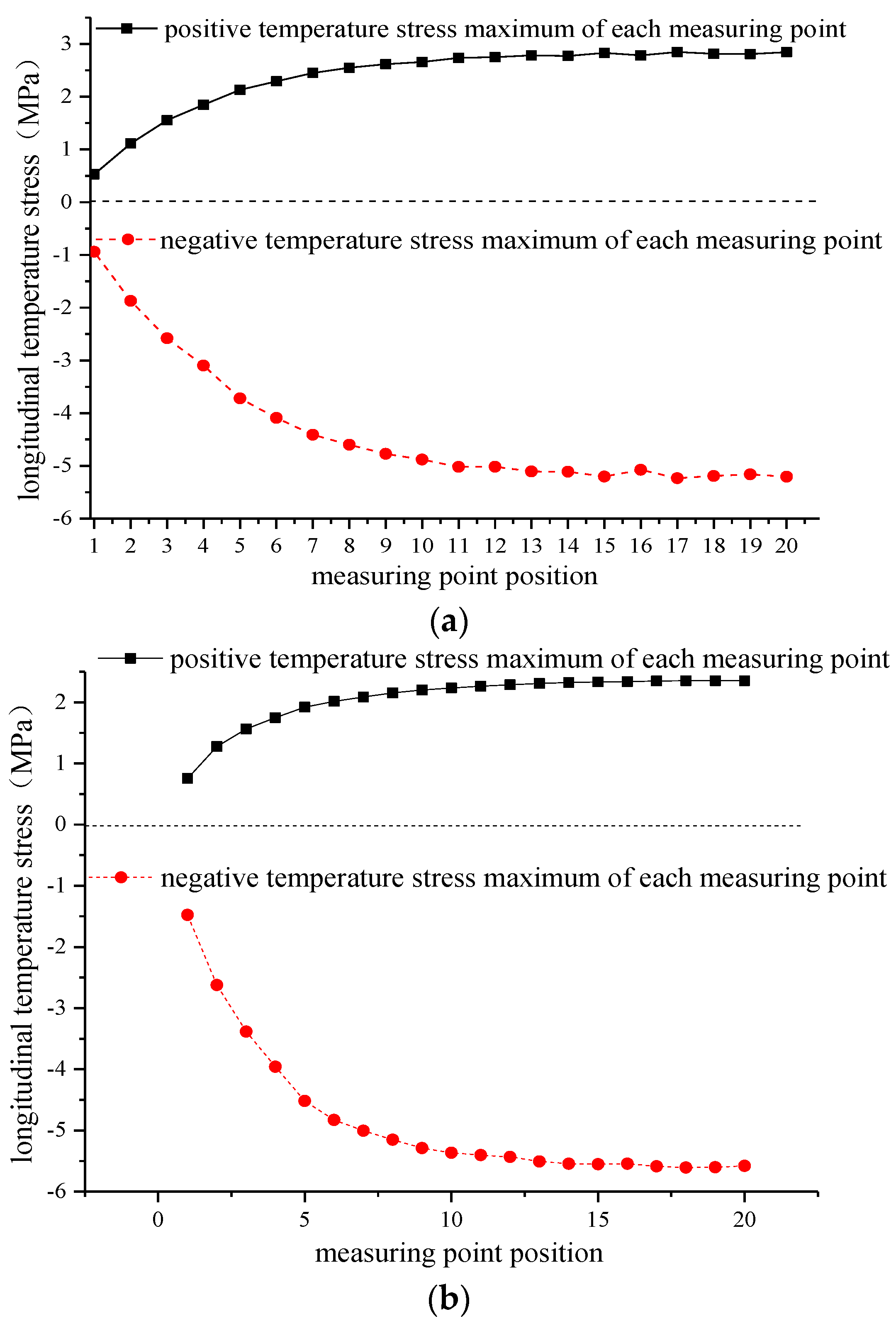

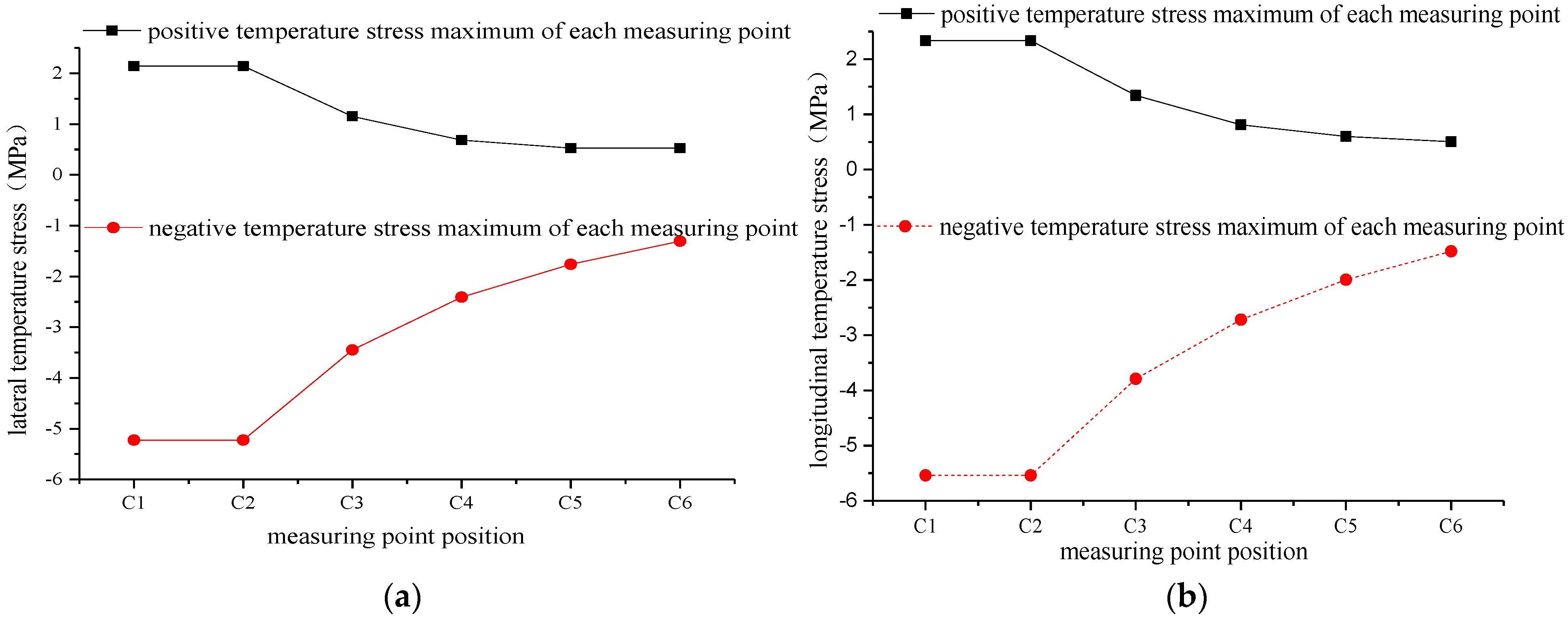

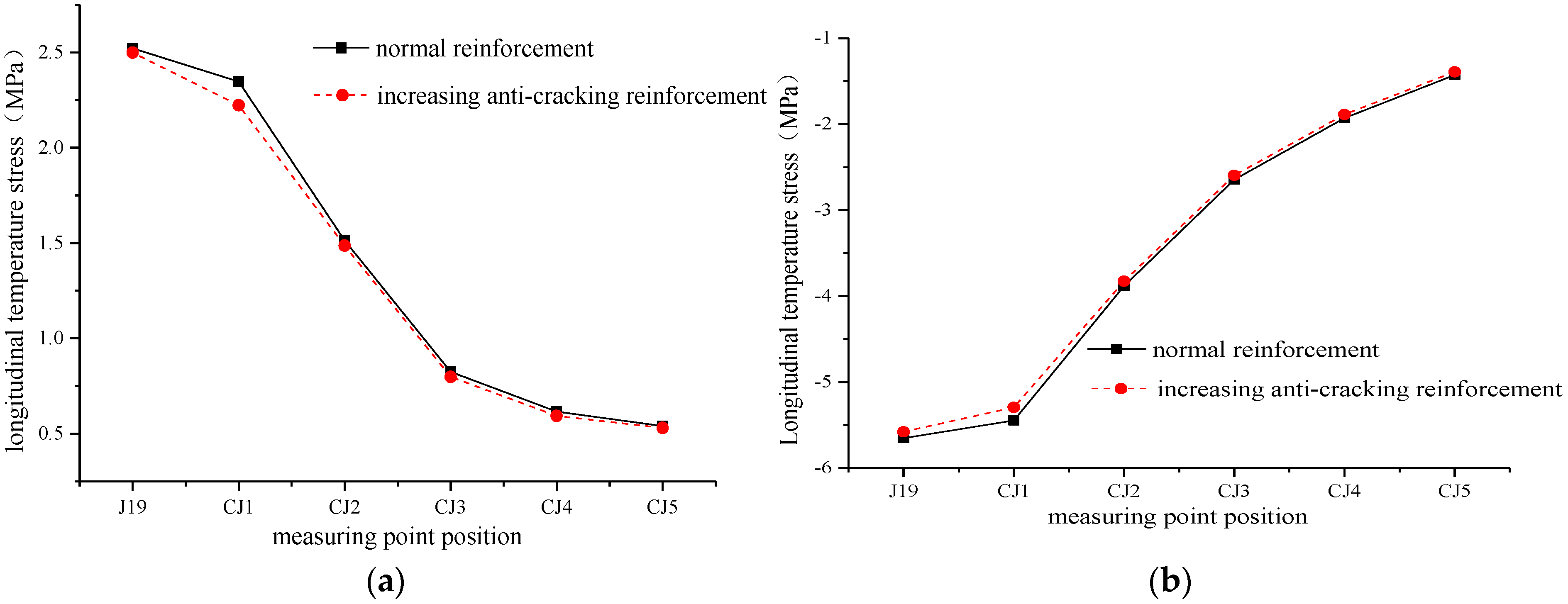

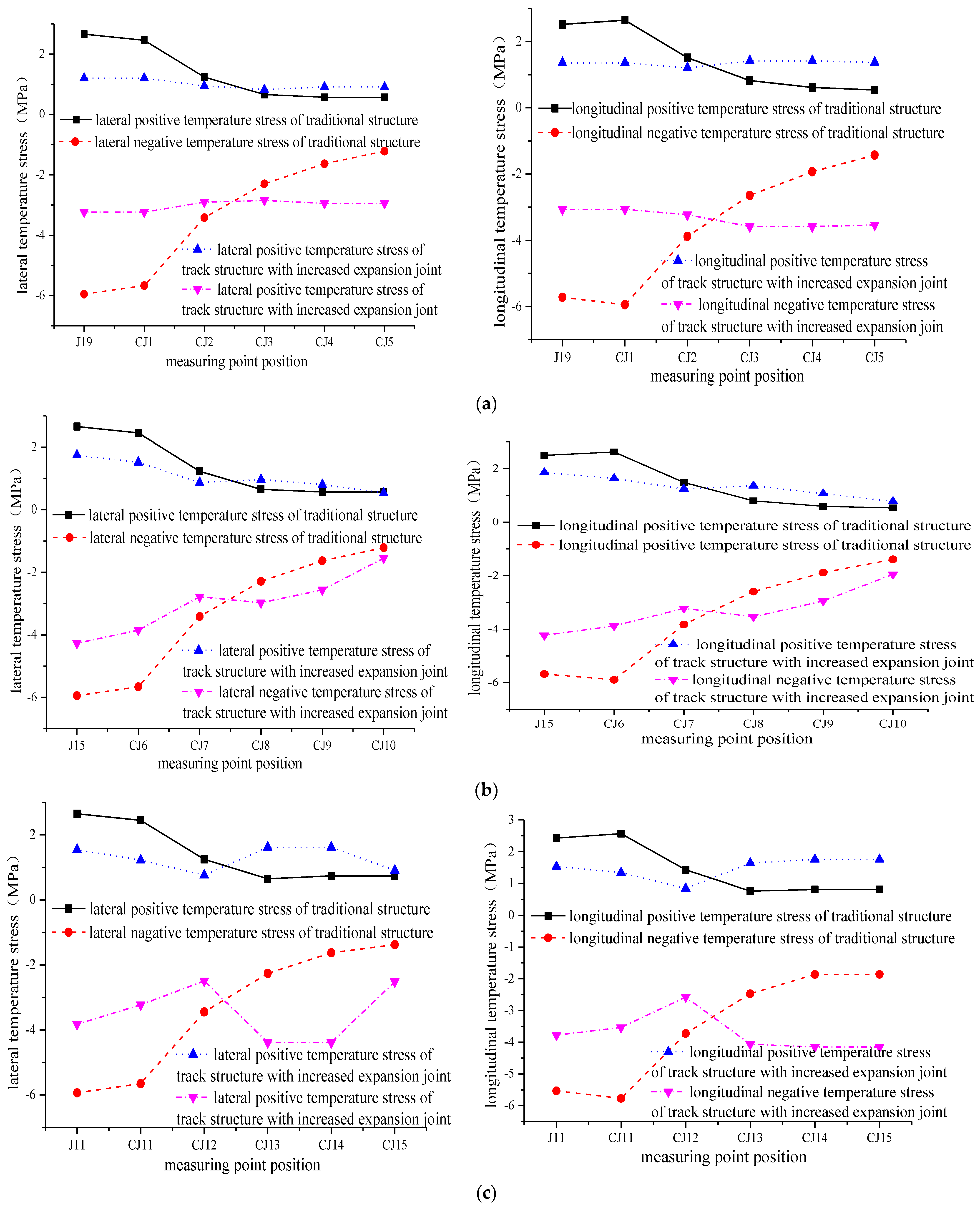

| Track Component | Physical Parameter | Numerical Value |
|---|---|---|
| Double-block sleeper | Density (kg/m3) | 2.5 × 103 |
| Thermal conductivity (W/m·k) | 1.74 | |
| Specific heat (J/kg·k) | 9.2 × 102 | |
| Elastic modulus (MPa) | 3.55 × 104 | |
| Coefficient of linear extensibility (1/°C) | 1.0 × 10−5 | |
| Poisson ratio | 0.2 | |
| Track slab | Density (kg/m3) | 2.5 × 103 |
| Thermal conductivity (W/m·k) | 1.74 | |
| Specific heat (J/kg·k) | 9.2 × 102 | |
| Elastic modulus (MPa) | 3.2 × 104 | |
| Coefficient of linear extensibility (1/°C) | 1.0 × 10−5 | |
| Poisson ratio | 0.2 | |
| Support layer | Density (kg/m3) | 2.5 × 103 |
| Thermal conductivity (W/m·k) | 1.74 | |
| Specific heat (J/kg·k) | 9.2 × 102 | |
| Elastic modulus (MPa) | 3.2 × 104 | |
| Coefficient of linear extensibility (1/°C) | 1.0 × 10−5 | |
| Poisson ratio | 0.2 | |
| Reinforcement | Density (kg/m3) | 7.85 × 103 |
| Thermal conductivity (W/m·k) | 58.2 | |
| Specific heat (J/kg·k) | 4.6 × 102 | |
| Elastic modulus (MPa) | 2.06 × 105 | |
| Coefficient of linear extensibility (1/°C) | 1.2 × 10−4 | |
| Poisson ratio | 0.3 |
Publisher’s Note: MDPI stays neutral with regard to jurisdictional claims in published maps and institutional affiliations. |
© 2022 by the authors. Licensee MDPI, Basel, Switzerland. This article is an open access article distributed under the terms and conditions of the Creative Commons Attribution (CC BY) license (https://creativecommons.org/licenses/by/4.0/).
Share and Cite
Zeng, Z.; Peng, G.; Wang, W.; Huang, X.; Shen, S.; Shuaibu, A.A.; Meng, X. Research on the Variable-Temperature Cracking Mechanism of CRTS I Type Double-Block Ballastless Track on a Bridge. Materials 2022, 15, 770. https://doi.org/10.3390/ma15030770
Zeng Z, Peng G, Wang W, Huang X, Shen S, Shuaibu AA, Meng X. Research on the Variable-Temperature Cracking Mechanism of CRTS I Type Double-Block Ballastless Track on a Bridge. Materials. 2022; 15(3):770. https://doi.org/10.3390/ma15030770
Chicago/Turabian StyleZeng, Zhiping, Guangzhao Peng, Weidong Wang, Xiangdong Huang, Shiwen Shen, Abdulmumin Ahmed Shuaibu, and Xiaobai Meng. 2022. "Research on the Variable-Temperature Cracking Mechanism of CRTS I Type Double-Block Ballastless Track on a Bridge" Materials 15, no. 3: 770. https://doi.org/10.3390/ma15030770





